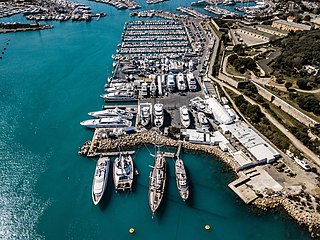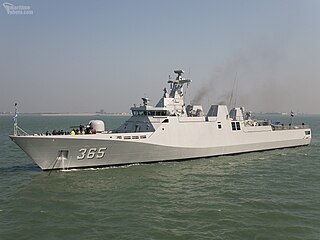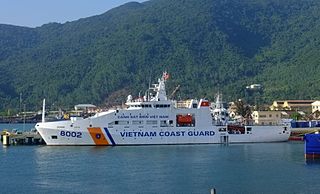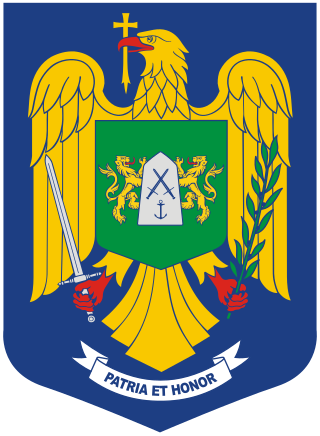Transportation infrastructure in Romania is the property of the state, and is administered by the Ministry of Transport and Infrastructure, Constructions and Tourism, except when operated as a concession, in which case the concessions are made by the Ministry of Administration and Interior.

A shipyard, also called a dockyard or boatyard, is a place where ships are built and repaired. These can be yachts, military vessels, cruise liners or other cargo or passenger ships. Compared to shipyards, which are sometimes more involved with original construction, dockyards are sometimes more linked with maintenance and basing activities. The terms are routinely used interchangeably, in part because the evolution of dockyards and shipyards has often caused them to change or merge roles.

Galați is a county (județ) of Romania, in Moldavia region, with the capital city at Galați, between 45°25'N and 46°10'N latitude, 27°20'E and 28°10'E longitude. It borders the counties of Vaslui, Vrancea, Brăila, Tulcea. To the east it borders the Republic of Moldova, the border crossing points being Galați–Giurgiulești and Oancea–Cahul (road). The county was established in 1968, through the territorial reorganization of the former Galați Region, which included a territory similar to that of the current Brăila and Galați counties, plus the northern part of Tulcea County.

The Romanian Naval Forces is the principal naval branch of the Romanian Armed Forces and operates in the Black Sea and on the Danube. It traces its history back to 1860.

The SIGMA class is a Dutch-built family of modular naval vessels, of either corvette or frigate size, designed by Damen Group.

The Damen Group is a Dutch defence, shipbuilding, and engineering conglomerate company based in Gorinchem, Netherlands.

The Romanian Border Police is the structure of the Romanian Ministry of Internal Affairs responsible for the border security and passport control at border crossing points, airports and ports.

The Holland-class ocean-going patrol vessels are a class of four ocean-going patrol vessels constructed for the Royal Netherlands Navy. They are designed to fulfill patrol and intervention tasks against lightly armed opponents, such as pirates and smugglers, but have much higher level electronic and radar surveillance capabilities which are used for military stabilization and security roles, short of outright war. Without sonar or long range weapons, they utilize the surveillance capabilities of the Thales integrated mast, which integrates communication systems and two four-faced phased arrays for air and surface search.

Constanța Shipyard is the largest shipyard in Romania and one of the largest in Europe having a market share of 20% in the Black Sea basin. The shipyard has two drydocks, one used for the construction of ships up to 150,000 tonnes deadweight (DWT), and the second one used for the construction of ships up to 250,000 DWT, and two floating docks with a capacity of 8,000 tonnes and 15,000 tonnes.

Mangalia shipyard is a large shipyard located 45 km (28 mi) south of the Port of Constanța, in Mangalia, Romania.

Shabab Oman II is a full-rigged ship which entered service with the Royal Navy of Oman in August 2014, replacing the current ship of the same name. She is a full-rigged ship which was built in Romania, fitted out in the Netherlands and launched in 2013.

NMS Marsuinul was a submarine of the Romanian Navy, one of the few warships built in Romania during the Second World War. She was the largest Romanian-built submarine and the most powerful and modern Axis submarine in the Black Sea.

NMS Mihail Kogălniceanu was a Brătianu-class river monitor of the Romanian Navy. She saw service in both world wars, being the most successful vessel in her class of four ships. Like her three sisters, she was initially built as a river monitor, but in early 1918, she was converted to a sea-going monitor. During the Second Balkan War, she supported the Romanian crossing of the Danube into Bulgaria. During World War I, she carried out numerous bombardments against the Central Powers forces advancing along the shore of the Danube and carried out the last action of the Romanian Navy before the 11 November 1918 armistice. She later fought successfully against Bolshevik naval forces during the early months of the Russian Civil War, helping secure the Budjak region.

NMS Rechinul was a submarine of the Romanian Navy, one of the few warships built in Romania during World War II and used during the war. She was made at the Galați shipyard in 1938, launched in 1941, and completed in 1942. Rechinul took part in the evacuation of the Crimea and later performed the longest mission in Romanian submarine history, starting on 15 June 1944 and lasting 45 days.

HNLMS Den Helder is a new replenishment oiler under construction for the Royal Netherlands Navy. Also known as the Combat Support Ship (CSS), Den Helder is planned to fill the gap of replenishment at sea that was left after HNLMS Amsterdam was sold to Peru in 2014.

The Snellius class are two hydrographic survey vessel (HOV) ships in service with the hydrographic branch of the Royal Netherlands Navy. The ships were built by the Damen Group, with the hull being built in Romania by Damen Shipyards Galați and the fitting out in the Netherlands by Damen Schelde Naval Shipbuilding.
Paul Păltănea was a Romanian historian. He was known as an outstanding researcher, author of scientific works, doctor in history, laureate of the Romanian Academy and member of the International Academy of Genealogy in Paris, the author of the monograph History of the city of Galați from its origins to 1918, a monumental work appreciated as one of the best monographs written in Romania.

NRP D. João II, also known as the Multifunctional Naval Platform, will be a multipurpose ship for the Portuguese Navy, capable of carrying out surveillance operations, oceanographic research, environmental and meteorological monitoring, as well as emergency evacuation missions.

NMS Ardeal was a Temes-class river monitor originally named SMS Temes while in Austro-Hungarian Navy service. Built in 1904, Temes was the lead ship of her class and served as flag ship of the Austro-Hungarian Danube Flotilla between 1908 and 1914. After a short service in the Yugoslav Navy, she was transferred to the Romanian Navy in 1920 and served with the Romanian Danube Flotilla in World War II until 1944 when she was taken over the Soviets. She was returned to Romania in 1951 and served as a training ship under the name M.20, later M.207, until 1959 when she was scrapped.


























